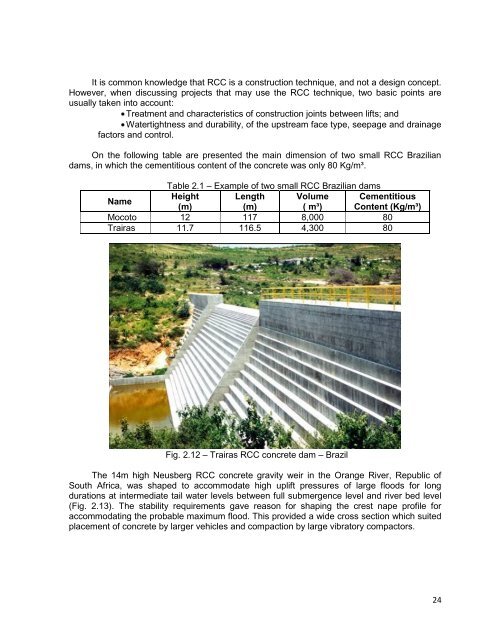SMALL DAMS PETITS BARRAGES
SMALL DAMS PETITS BARRAGES
SMALL DAMS PETITS BARRAGES
- TAGS
- dams
- petits
- barrages
- cbdb.org.br
Create successful ePaper yourself
Turn your PDF publications into a flip-book with our unique Google optimized e-Paper software.
It is common knowledge that RCC is a construction technique, and not a design concept.<br />
However, when discussing projects that may use the RCC technique, two basic points are<br />
usually taken into account:<br />
Treatment and characteristics of construction joints between lifts; and<br />
Watertightness and durability, of the upstream face type, seepage and drainage<br />
factors and control.<br />
On the following table are presented the main dimension of two small RCC Brazilian<br />
dams, in which the cementitious content of the concrete was only 80 Kg/m³.<br />
Table 2.1 – Example of two small RCC Brazilian dams<br />
Name<br />
Height<br />
(m)<br />
Length<br />
(m)<br />
Volume<br />
( m³)<br />
Cementitious<br />
Content (Kg/m³)<br />
Mocoto 12 117 8,000 80<br />
Trairas 11.7 116.5 4,300 80<br />
Fig. 2.12 – Trairas RCC concrete dam – Brazil<br />
The 14m high Neusberg RCC concrete gravity weir in the Orange River, Republic of<br />
South Africa, was shaped to accommodate high uplift pressures of large floods for long<br />
durations at intermediate tail water levels between full submergence level and river bed level<br />
(Fig. 2.13). The stability requirements gave reason for shaping the crest nape profile for<br />
accommodating the probable maximum flood. This provided a wide cross section which suited<br />
placement of concrete by larger vehicles and compaction by large vibratory compactors.<br />
24














